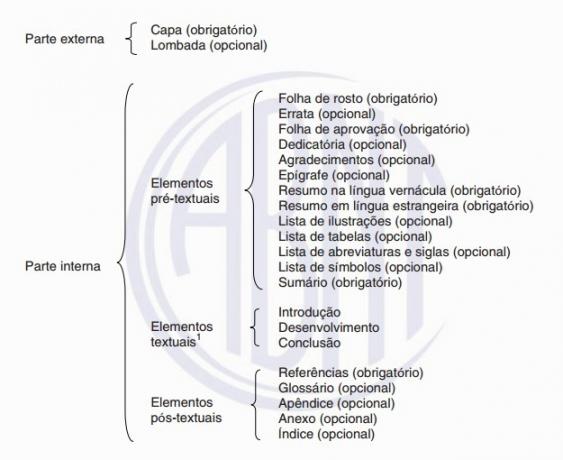Pre-textual elements are those that appear in academic papers (such as the TCC, for example) before the development of the main text.
The function of these components is to contribute to a good presentation of the work, helping to organize and explain ideas.
As with the rest of the work, the pre-textual elements must follow the ABNT norms and have an order in which they must appear.
See the structure with all the elements of an academic text and the order they should be inserted:

1. Cover
The cover is a mandatory item. It is the work that involves the work and, generally, it is made in rigid material or using a cover standardized by the institution.
The information that must be present is:
- Name of educational institution;
- Name of the author of the work (student);
- Title and subtitle (it is not mandatory to have a subtitle);
- Number of volumes (if more than one volume is applicable);
- City where the institution is located;
- Year the work was delivered.
Read too: How to make ABNT work cover (model and guide)
2. cover sheet
The cover page is also mandatory and repeats some of the information contained on the cover, in addition to providing more information about the work.
They must compose the cover sheet:
- Author's name;
- Title and subtitle;
- Category to which the work belongs (monograph, thesis, course conclusion work, etc.);
- Purpose (which objective you want to achieve, such as approval in graduation or master's, etc);
- Institution Name;
- Concentration area;
- Name of the advisor or advisor;
- City of the institution;
- Year.
Read too: ABNT cover sheet
3. Errata
This part is intended to correct possible errors in the work. Therefore, it is not mandatory and should only be entered if necessary.
4. Approval Sheet
The approval sheet is mandatory. It is where the information regarding the evaluation of the work will be placed. Integrate this component:
- Student's name;
- Title and subtitle;
- Category to which the work belongs (TCC, thesis)
- Intended objective;
- Institution Name;
- Concentration area;
- Date the work was approved;
- Name of people on the examining board, as well as their degrees, signatures and institutions;
5. Dedication and thanks
The dedication and acknowledgments are optional elements and must come after the approval sheet, being inserted in separate sheets.
Read too:
- TCC Acknowledgments (Ready Templates and Examples)
- TCC dedication (ready sentences)
6. Title
The epigraph is a quote that is placed in the work as a reference and inspiration. Thus, it already gives the reader an idea of the concepts and values that guided the text. It is an optional component.
Read too: Title for TCC
7. Summary
This is a mandatory component and must be done in a single paragraph containing 150 to 500 words. It is also necessary that the text be in the third person singular and in active voice.
In addition to the summary in the vernacular language (Portuguese language, in this case), it is also necessary that the paragraph be in a foreign language, normally being English, Spanish or French.
After the explanatory text about the work, there should be keywords that further summarize the subject.
Read too: TCC Summary
8. lists
Lists are optional and must be inserted if the work has any type of image, such as photographs, drawings, graphs or tables.
There are also lists of abbreviations and acronyms, which must be inserted in alphabetical order, and lists of symbols, inserted in the order they appear in the body of the text.
9. summary
The summary is mandatory and must contain the integral parts of the general work. However, cover sheets, approval sheets, and summaries are not placed in the summary.
You may also be interested:
- How to make a Summary (ABNT rules)
- How to make a monograph
- TCC Presentation
- ABNT bibliographic references: how to do it?
- ABNT standards: formatting rules for academic papers

